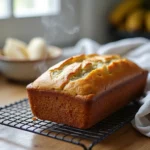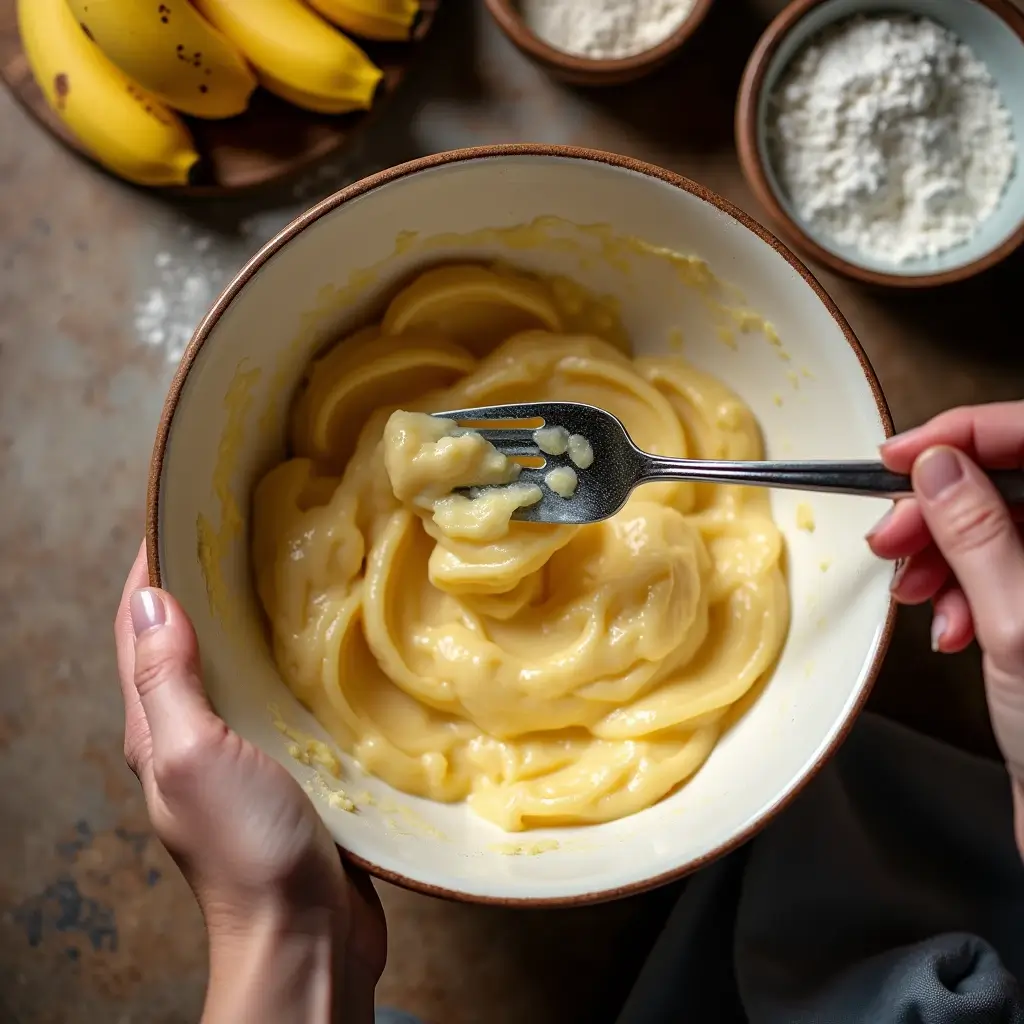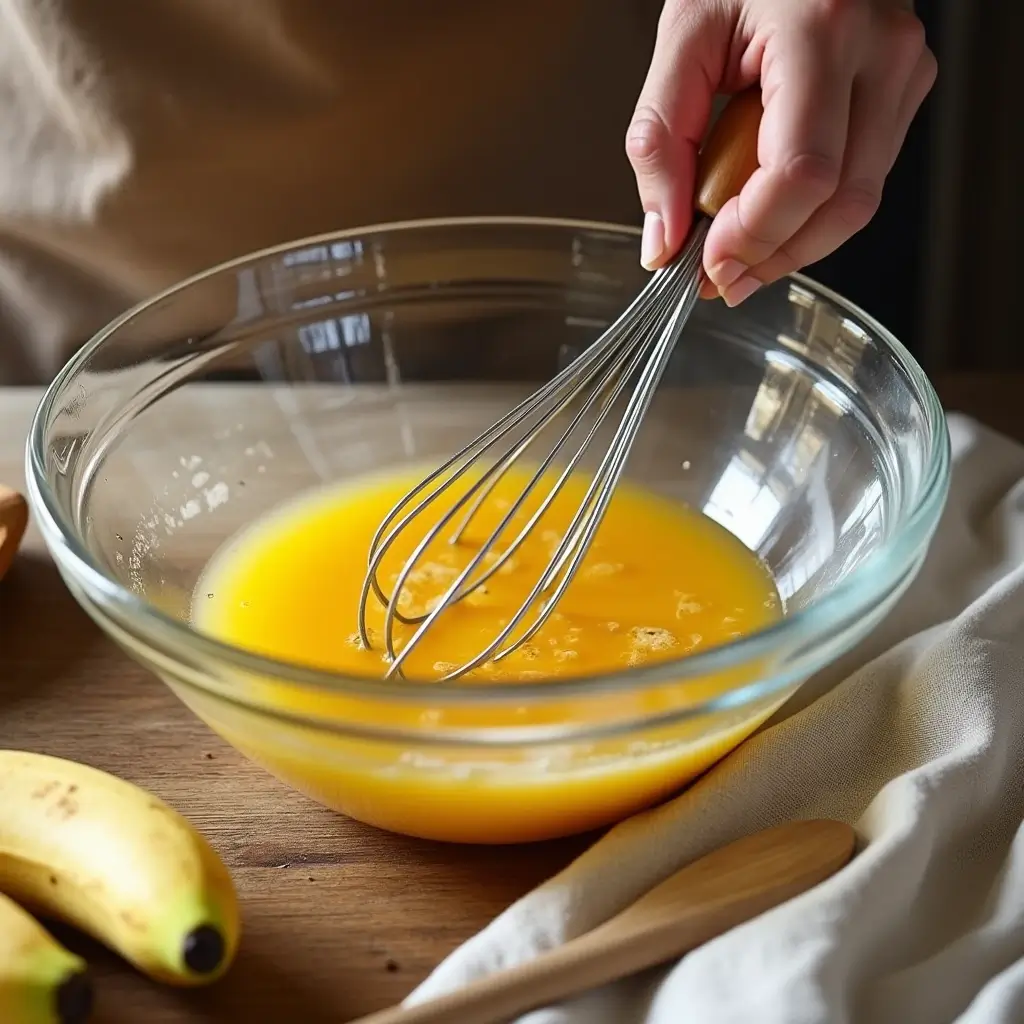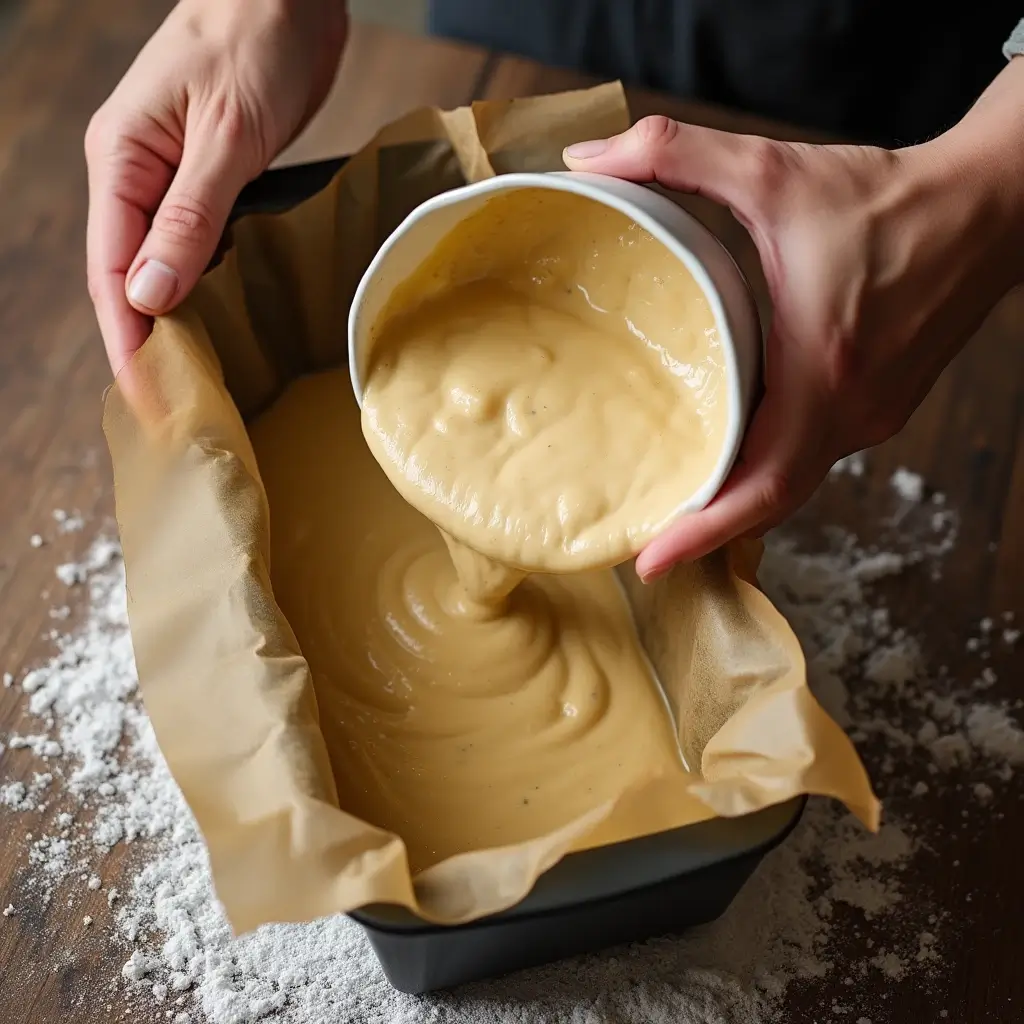Introduction
Banana bread recipe mastery became my obsession after a spectacular kitchen failure on a rainy Tuesday morning three years ago. I’m Lola from KitchenByLola, and that day still makes me laugh – I was determined to use up four blackened bananas sitting sadly in my fruit bowl, armed with confidence and my grandmother’s handwritten recipe card. What emerged from my oven looked more like banana concrete than bread, dense enough to use as a doorstop and about as appetizing. My husband took one polite bite, smiled bravely, and suggested maybe we should order pizza instead.
That humbling moment sparked something in me – a determination to crack the code of the perfect banana bread recipe. I spent the following months experimenting, tweaking, and testing different techniques, filling my kitchen with the sweet aroma of countless batches while my family became willing taste-testers. Some attempts were too dry, others too gummy, and a few were surprisingly successful. Through this delicious trial-and-error process, I discovered that exceptional banana bread recipe results come from understanding not just what to do, but why each step matters.

Today, I’m excited to share the banana bread recipe that has become legendary in my neighborhood – friends actually request it for special occasions, and my kids’ friends always ask if there’s any available when they visit. This isn’t just another banana bread recipe; it’s a collection of hard-won secrets, troubleshooting tips, and personal discoveries that will transform your baking forever.
Table of Contents
Table of Contents
Understanding the Foundation of Great Banana Bread Recipe Success
Creating an outstanding banana bread recipe requires recognizing that this beloved quick bread operates on different principles than traditional yeast breads. The magic happens through chemical leavening and the unique properties of mashed bananas, which serve simultaneously as flavor agent, sweetener, and moisture contributor.
My ideal banana bread recipe produces a loaf with golden-brown crust that yields to gentle pressure, revealing an interior that’s moist but not wet, sweet but not cloying, and sturdy enough to support generous spreads of butter or cream cheese. The crumb should tear apart in soft, irregular pieces rather than crumbling into dry fragments.
Through extensive testing, I’ve learned that successful banana bread recipe execution depends on three critical factors: ingredient temperature harmony, mixing methodology, and precise timing. These elements work together to create the tender, flavorful results that make banana bread recipe preparation so rewarding.
Print
The Best Ultimate Banana Bread Recipe
Description
Moist, tender, and loaded with banana flavor, this ultimate banana bread recipe is a one-bowl wonder. Perfect for breakfast, snacking, or dessert, it’s easy to make and impossible to resist. This is your go-to recipe for using up ripe bananas and filling your kitchen with the comforting aroma of homemade goodness.
Ingredients
3 ripe bananas (about 1¼ to 1½ cups mashed)
1/3 cup melted butter (unsalted)
3/4 cup brown sugar (or white sugar)
1 large egg, beaten
1 teaspoon vanilla extract
1 teaspoon baking soda
Pinch of salt
1½ cups all-purpose flour
Optional: 1/2 cup chopped walnuts or chocolate chips
Instructions
Preheat oven to 350°F (175°C). Grease a 9×5-inch loaf pan or line with parchment paper.
In a large mixing bowl, mash the bananas with a fork until mostly smooth.
Stir in melted butter until combined.
Add sugar, egg, and vanilla; mix well.
Sprinkle baking soda and salt over the mixture and stir to blend.
Gently fold in flour, mixing just until no streaks remain.
If using, fold in nuts or chocolate chips.
Pour the batter into the prepared loaf pan and smooth the top.
Bake for 50–60 minutes, or until a toothpick inserted into the center comes out clean.
Let cool in the pan for 10 minutes, then transfer to a wire rack to cool completely.
Notes
The riper the bananas, the sweeter and more flavorful the loaf.
For extra moist bread, reduce flour slightly and don’t overmix.
You can store banana bread wrapped at room temperature for up to 3 days or freeze it for up to 3 months.
The best banana bread recipe also adapts beautifully to personal preferences and dietary needs. Whether you prefer nuts, chocolate chips, or warm spices, understanding the foundational principles allows for creative variations while maintaining structural integrity.
Selecting and Preparing Your Banana Bread Recipe Ingredients
Choosing Perfect Bananas
The heart of any exceptional banana bread recipe lies in banana selection. I’ve discovered that bananas with completely black peels often work better than those with just brown spots. These super-ripe fruits have converted starches to sugars, creating natural sweetness that reduces reliance on added sugar in your banana bread recipe.
My favorite technique involves collecting bananas as they reach peak ripeness and storing them in the freezer until I’m ready to bake. Frozen bananas thaw into incredibly soft, easily mashed fruit that incorporates seamlessly into banana bread recipe batters. Simply thaw completely and drain any excess liquid before measuring.
For optimal banana bread recipe results, you’ll want approximately 1½ cups of mashed banana, which typically requires 3-4 large fruits. Slightly chunky mashing creates pleasant texture variations throughout the finished loaf.
Flour and Structural Components
All-purpose flour provides the ideal protein content for banana bread recipe success, creating enough structure without developing excessive gluten. I measure flour using the spoon-and-level method, which prevents the compression that can lead to dry, heavy results.
Some bakers enhance their banana bread recipe by substituting up to ¼ cup of flour with cornstarch, creating exceptionally tender texture. This technique works particularly well when incorporating heavy add-ins like nuts or chocolate chips.
Room temperature ingredients blend more harmoniously in banana bread recipe preparation. Cold butter or eggs can create lumpy batters that require additional mixing, potentially leading to tough results.
Sweetening and Enriching Elements
While overripe bananas contribute significant natural sweetness, most banana bread recipe formulations benefit from added sugar for proper texture and browning. I prefer combining granulated sugar with a small amount of brown sugar, which adds molasses notes that complement banana flavor beautifully.
Melted butter creates richer flavor than oil in banana bread recipe applications, though oil produces slightly moister results. My preferred approach combines both – mostly butter for flavor with a small amount of neutral oil for moisture insurance.
Fresh eggs at room temperature emulsify more easily into banana bread recipe batters, creating smoother consistency and more even texture in the finished product.
My Perfected Banana Bread Recipe Method
Initial Setup and Preparation
Transform your kitchen into an efficient baking station by preheating your oven to 350°F and preparing your 9×5-inch loaf pan with butter and a light flour dusting. I line the bottom with parchment paper, leaving overhang for easy removal – this simple step prevents sticking and makes cleanup effortless.

Gather all ingredients and arrange them in the order you’ll use them. This mise en place approach prevents forgotten ingredients and ensures smooth banana bread recipe execution. Room temperature ingredients are crucial, so plan accordingly or use gentle warming techniques for cold items.
Creating the Perfect Batter
Begin your banana bread recipe by mashing bananas in a large mixing bowl until mostly smooth with some texture remaining. Add ⅓ cup melted butter (cooled slightly), one beaten egg, ¾ cup granulated sugar, and 1 teaspoon vanilla extract. Stir until well combined – this wet mixture forms the foundation of your banana bread recipe.
In a separate bowl, whisk together 1½ cups all-purpose flour, 1 teaspoon baking soda, and ½ teaspoon salt. This dry mixture distributes leavening agents evenly throughout your banana bread recipe.
The crucial moment in banana bread preparation comes when combining wet and dry ingredients. Lumpy batter is completely acceptable – overmixed batter creates tough, dense results.
Baking to Perfection
Transfer your banana bread batter to the prepared pan, spreading evenly without overworking. The surface should look slightly rough rather than perfectly smooth.
Bake for 55-65 minutes, checking for doneness with a toothpick inserted in the center. Properly baked banana bread results show just a few moist crumbs clinging to the tester – completely clean means overbaked.
Allow your banana bread creation to cool in the pan for exactly 10 minutes before turning out onto a wire rack. This brief rest period sets the structure while preventing soggy bottoms.
Avoiding Common Banana Bread Recipe Pitfalls
The Overmixing Trap
The most devastating mistake in banana bread preparation is excessive mixing after flour addition. I learned this lesson painfully in my early baking days – what should have been tender bread became chewy and dense. Gluten development from overmixing creates tough texture that no amount of additional ingredients can fix.
Mix just until dry ingredients disappear into wet ingredients. A few flour streaks are acceptable; lumpy batter is preferable to smooth, overworked batter in banana bread recipe success.

Temperature Troubles
Oven temperature accuracy critically affects banana bread outcomes. Too hot creates burnt exteriors with raw centers; too cool produces dense, heavy loaves. Invest in an oven thermometer and adjust accordingly – many home ovens run 25 degrees off their settings.
I’ve found that starting banana bread baking at 350°F produces consistently excellent results across different oven types and ages.
Timing and Patience Issues
Impatience ruins more banana bread attempts than any other single factor. Cutting into hot bread releases steam that condenses into gummy texture. Similarly, removing bread from the pan too quickly can cause structural collapse.
Trust the cooling process – your banana bread deserves proper rest time to achieve optimal texture and clean slicing capability.
Creative Banana Bread Recipe Variations
Chocolate Enhancement Options
Elevate your basic banana bread by incorporating ¾ cup mini chocolate chips, folded gently into the batter during final mixing. The size of chocolate pieces matters – mini chips distribute more evenly than large chunks.
For deeper chocolate flavor, substitute 2 tablespoons of flour with unsweetened cocoa powder in your banana bread. This creates rich, fudgy results that chocolate lovers adore.
Nutty Additions and Textures
Toasted walnuts or pecans add delightful crunch to banana bread creations. Toast nuts in a dry skillet until fragrant before chopping and adding ½ to ¾ cup to your batter.
I’ve discovered that combining nuts with dried fruit creates bakery-style complexity in home banana bread results. Try cranberries with walnuts or dates with pecans for sophisticated flavor profiles.
Spice Blending Adventures
Transform your banana bread with warm spice combinations. Cinnamon pairs naturally with banana, but don’t overlook cardamom, nutmeg, or allspice for unique flavor developments.
My signature spice blend combines ½ teaspoon cinnamon, ¼ teaspoon nutmeg, and a pinch of cardamom. These amounts enhance without overwhelming the banana bread recipe’s natural flavors.
Healthier Banana Bread Recipe Modifications
Greek yogurt can replace up to ¼ cup of butter in banana bread recipe applications, reducing fat while maintaining moisture. Start with small substitutions and adjust based on results.
Storage and Serving Strategies
Proper storage maximizes your banana bread investment. Completely cooled bread wrapped tightly in plastic wrap stays fresh at room temperature for four days.
Serving banana bread creations at room temperature showcases optimal flavor and texture. Gentle warming in a toaster or low oven enhances aroma and creates appealing presentation.
Troubleshooting Your Banana Bread Recipe Results
Dense, Heavy Texture Solutions
Dense banana bread outcomes typically result from too much flour, insufficient leavening, or overmixing. Measure flour accurately using proper techniques and ensure your baking soda is fresh – replace every six months for optimal effectiveness.
Check your mixing method and reduce stirring time if texture issues persist in your banana bread recipe attempts.
Dry, Crumbly Problems
Dry banana bread results suggest overbaking or insufficient moisture content. Reduce baking time slightly and ensure your bananas are properly ripened for maximum moisture contribution.
Consider adding an extra tablespoon of butter or oil to your banana bread if dryness continues to be problematic.
Gummy Interior Issues
Gummy texture in banana bread centers indicates underbaking or too much liquid content. Verify oven temperature accuracy and extend baking time if necessary.
Excessive banana quantity can create gummy results – stick to recommended measurements in your banana bread recipe for best outcomes.
Professional Tips for Banana Bread Recipe Excellence
Ingredient Temperature Management
Room temperature ingredients blend more smoothly in banana bread recipe preparation, creating better emulsification and more even texture. Plan ahead by removing eggs and butter from refrigeration 1-2 hours before baking.
Quick warming techniques include placing eggs in warm water for 10 minutes or grating cold butter for faster temperature equilibration.
Advanced Mixing Techniques
Professional bakers often use the reverse creaming method for tender banana bread recipe results. Combine flour and sugar first, then add softened butter gradually. This technique creates exceptionally fine crumb structure.
Alternative mixing approaches can enhance your banana bread outcomes, but master the basic method before experimenting with advanced techniques.
Flavor Development Secrets
A splash of bourbon or rum in banana bread batters adds sophisticated depth without overwhelming banana flavors. Start with 1 tablespoon and adjust to taste.

External Resources for Enhanced Banana Bread Recipe Knowledge
For comprehensive baking science explanations, King Arthur Baking offers detailed ingredient function discussions that complement banana bread recipe understanding.
The Serious Eats Food Lab provides scientific approaches to baking problems, including troubleshooting guides that enhance banana bread recipe success rates.
Professional techniques and advanced methods can be found at America’s Test Kitchen, where rigorous testing produces reliable banana bread recipe improvements.
For food safety guidelines and proper storage techniques, consult USDA Food Safety resources that ensure your banana bread recipe creations remain safe and delicious.
Frequently Asked Questions
What is the number one mistake made when making banana bread?
The biggest mistake in banana bread recipe preparation is definitely overmixing the batter once you add flour. I learned this the hard way during my early baking experiments – I thought smooth batter meant better bread, but I was completely wrong. When you mix too vigorously or for too long after adding flour, you develop the gluten proteins, which creates tough, chewy, dense bread instead of the tender, moist texture we’re after. The secret is mixing just until you can’t see dry flour anymore, even if the batter looks lumpy and rough. Those lumps will disappear during baking, leaving you with perfectly tender banana bread.
What are the ingredients of banana bread?
My go-to banana bread recipe uses simple, everyday ingredients that you probably already have in your kitchen: 3-4 very ripe bananas (the blacker the better), ⅓ cup melted butter, ¾ cup granulated sugar, 1 large egg, 1 teaspoon vanilla extract, 1½ cups all-purpose flour, 1 teaspoon baking soda, and ½ teaspoon salt. That’s it! The beauty of banana bread lies in its simplicity – no fancy ingredients or complicated techniques required. You can certainly dress it up with add-ins like chocolate chips, nuts, or spices, but these eight basic ingredients create the foundation for incredible banana bread every single time.
What makes banana bread moist and fluffy?
The secret to moist and fluffy banana bread success lies in several key factors working together harmoniously. First, those super-ripe bananas with black peels provide natural moisture and sugars that keep the bread tender. Second, proper mixing technique is crucial – gentle stirring preserves air bubbles and prevents tough gluten development. Finally, accurate baking time and temperature ensure the interior sets properly without overcooking. I’ve also discovered that letting ingredients come to room temperature before mixing creates smoother batters that bake more evenly, resulting in that perfect moist, fluffy texture everyone loves.
Can you make banana bread with fresh bananas?
While you technically can use fresh bananas in a banana bread, I really don’t recommend it if you want the best results. Fresh bananas lack the developed sugars and soft texture that make banana bread special – they’re starchy rather than sweet, and they won’t mash easily into the batter. If you’re stuck with fresh bananas, you can speed up the ripening process by placing them in a paper bag with an apple overnight. However, I always tell people to plan ahead and let those bananas ripen naturally on the counter until they’re covered in brown spots or even completely black – your patience will be rewarded with infinitely better banana bread.
Conclusion
My banana bread recipe journey has taught me that baking success comes from understanding principles rather than just following instructions blindly. Every technique I’ve shared emerged from real kitchen experiences – the disasters that taught me what not to do, and the triumphs that showed me what excellence looks like when everything comes together perfectly.
The transformation from that first concrete-like failure to consistently creating bakery-quality loaves didn’t happen overnight, but each batch taught me something valuable about the science and art of banana bread mastery. Now, when I pull a golden, aromatic loaf from my oven, I feel the same sense of accomplishment and joy that I hope you’ll experience with your own baking adventures.
Remember that your banana bread recipe success depends on patience, gentle handling, and trusting the process even when things don’t look perfect. Those spotted bananas sitting on your counter aren’t waste – they’re potential waiting to be transformed into something wonderful that brings comfort and happiness to everyone who tastes it.
I encourage you to start with my basic banana bread recipe, then make it your own through experimentation and personal touches. Whether you’re baking for weekend breakfast, gifting to neighbors, or simply treating yourself to a slice of homemade goodness, this banana bread recipe will become a cherished part of your kitchen repertoire. Happy baking, and remember – every great baker started with their first loaf, so embrace the journey and enjoy every delicious step along the way.